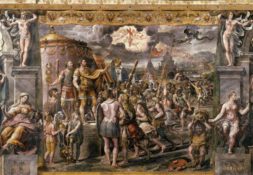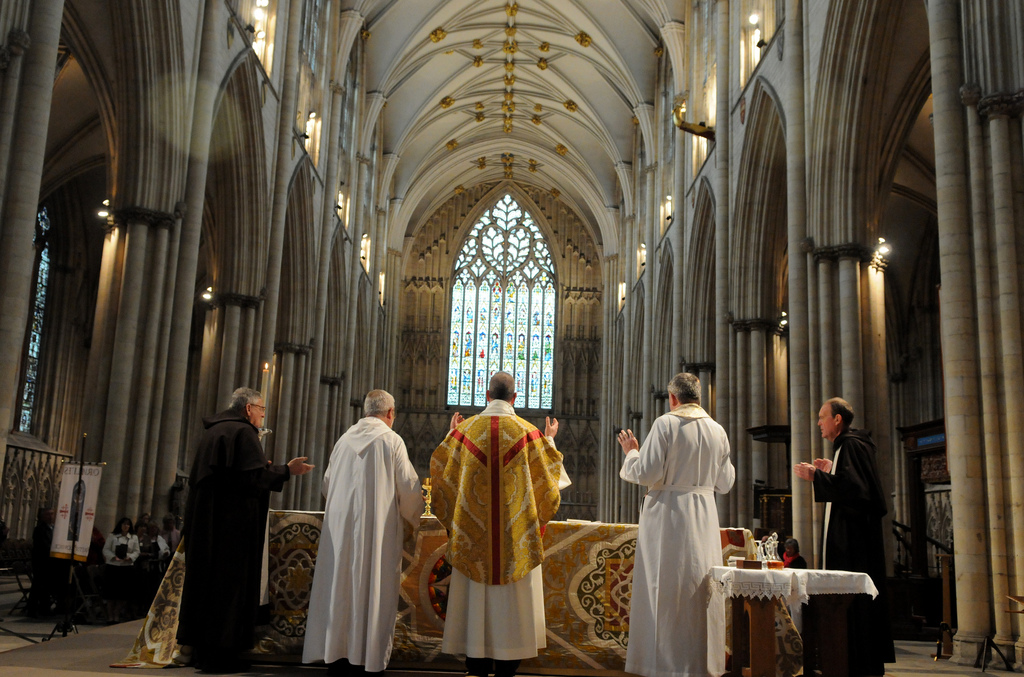As a freshman, Mary’s open arms atop the Golden Dome welcomed me to campus. Halfway through my senior year, it’s almost Christmas. Decorations will soon be hung, and Mary will be beside the manger. What I’ve learned over the last three and a half years is that Notre Dame is built on a foundation of stories, accounts that are inspired by half-glimpses, bits-and-pieces that stoke the imagination, and sometimes lead to a deeper understanding.
The Blessed Mother is one of Scripture’s most significant figures. She is the Immaculate Conception and the Mother of God. Her story is as old as Christmas and has been retold throughout the ages many times, including by our own Father Edward Sorin. As time grows short in my senior year, I’ve begun to rethink my first impression of the Golden Dome as an invitation from a profound storyteller.
In the Catholic tradition, there are many manifestations of Our Lady. Perhaps none is more enigmatic than the one that Father Sorin chose as the defining image of the University of Notre Dame: The Woman of the Apocalypse.
G.K. Chesterton, the British writer and theologian took note of it in a 1930 visit to campus. He wrote:
“I have seen, where a strange country
Opened its secret plains about me,
One great golden dome stand lonely with its golden image, one
Seen afar, in strange fulfillment,
Through the sunlit Indian summer
That Apocalyptic portent that has clothed her with the Sun.”
Chesterton’s ‘Apocalyptic portent’ sparked my imagination, referring me to Revelation 12 where the Woman of the Apocalypse confronts the serpent at the end of time. Here, in the last book of the Bible, is a different manifestation of Mary than the young girl who proclaimed the universe altering ‘yes’ to the Angel Gabriel.
“Now a great sign appeared in heaven: a woman clothed with the sun, with the moon under her feet, and on her head a garland of twelve stars. Then being with child, she cried out in labor and in pain to give birth (Revelation 12: 1-2).”
Prompted by this enigmatic chapter and seeking to learn more, I began to search for close-up, aerial photographs of Father Sorin’s golden image. Upon inspection, it became clear that Our Lady atop the Golden Dome does not stand alone. She is with child. But in this stirring image, Christ, who typically defends the faithful, is being protected by his heroic mother.
This realization temporarily disrupted a familiar narrative. Assuming the posture of an action hero, the Woman of the Apocalypse reflects Father Sorin’s determination to draw his audience into a deeper conversation about Our Lady. This amazing choice of imagery demonstrates Father Sorin’s ability to frame the heroic narrative, exalting his university’s patroness as fully engaged in the cosmic battle between good and evil.
Also, in this account, we find a hint as to the true nature of evil. In Revelation, the dragon is described as “enormous” with “seven heads and ten horns.” Yet the pregnant and unarmed woman emerges triumphant. Could it be that when we summon the bravery to confront him, the devil, with all his pomps and works, is revealed to be a coward?
The devil makes his first appearance in Genesis. God identifies the antagonism between the snake and the woman and foretells that the woman will one day crush the serpent’s head.
“And I will put enmity between thee and the woman and between thy seed and her seed; that seed shall bruise thy head, and thou shalt bruise his heel (Genesis 3:15).”
Another one of Mary’s titles is the “Undoer of Knots.” This title is derived from her role as the ‘new Eve.’ Eve falls from grace in Eden only to be restored with a gallant ‘yes’ from her progeny, at the Annunciation. Like Eve, Mary was conceived without sin. Like Eve, Mary was confronted with a question. Unlike Eve, Mary chose obedience to God. By this obedience, she achieved a mantle of glory and assumed a character of heroic responsibility.
There is a wholeness to this understanding of the Biblical account. Sin and death began in the garden with Adam and Eve. Consequently, it takes a dynamic duo, Jesus Christ and His Mother, to restore grace. This heroic symmetry reaffirms the New Testament’s most important earthly relationship along with Father Sorin’s ‘Apocalyptic portent’ in the woods of Indiana.
A week after his arrival at Notre Dame, Father Sorin wrote to Father Moreau saying, “May this new Eden be always the refuge of innocence and virtue. Here I could willingly exclaim with the prophet, ‘The Lord ruleth me… He hath brought me upon the water of refreshment.’” There is a sweetness and beauty to Notre Dame that remains to this day. And it is protected by Our Lady, just as she protected her child Jesus.
Father Sorin once said of Mary: “I shall raise her aloft so that, without asking, all men shall know why we have succeeded here. To that lovely Lady, raised high on a dome, a Golden Dome, men may look and find the answer.” To this day, she watches over us.
As it turns out, Father Sorin was more than the founder of a small school on the American frontier. He was a master storyteller and visionary, who bestowed upon Notre Dame an identity both powerful and enigmatic. Like the Bible itself, Our Lady is not an easy read. Every day I see her, I am reminded to be grateful for those half-glimpses – bits and pieces that stoke the imagination and – if we’re lucky – lead to a deeper understanding.
Michael Singleton is a senior majoring in finance and theology. He can’t wait for Christmas. Contact him at mikesingleton3@gmail.com.






Leave a Reply